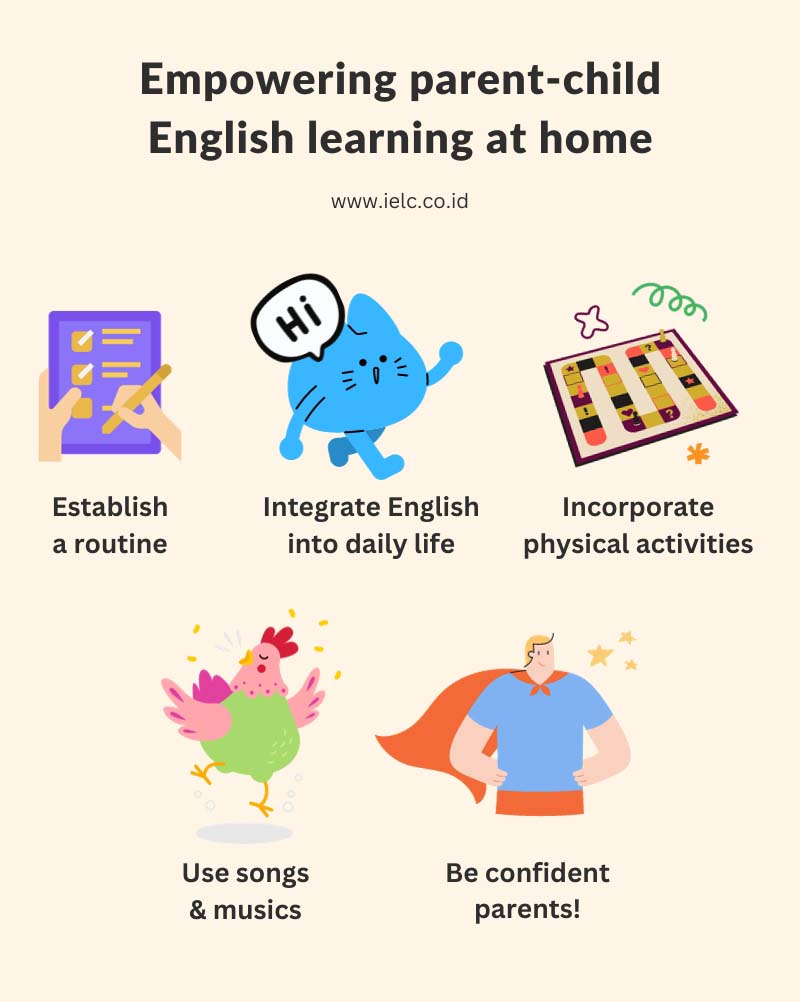
Parents’ guide to stress-free English teaching at home: 5 tips you need to know
Welcome, moms and dads!
As parents, we all dream of providing the best for our children, and in today’s global landscape, being fluent in English opens a world of opportunities for them.
But what if you, as a parent, feel your own English skills aren’t up to par?
Maybe you stumble over grammar, find pronunciation challenging, or simply lack confidence in your language abilities. If this sounds like you, you’re not alone—and most importantly, you’re more qualified to help your child learn English than you might think!
Let’s address a common worry head-on: this isn’t about lofty theories or complex grammar rules that might feel overwhelming. Our focus here is on practical, easy-to-implement strategies that you can weave into everyday life. This blog is dedicated to showing you how, with the right approach and tools, you can effectively nurture your child’s English skills, and perhaps even improve your own along the way!
In the following sections, we’ll delve into practical tips and strategies that are not only effective but also enjoyable, making the process of learning English a bonding experience rather than a daunting task.
From using technology to our advantage to incorporating English into daily routines, we’ve got you covered. So, take a deep breath, and let’s get started on this exciting adventure in language learning!

1. Establish a routine
One of the most effective ways to ensure your child’s success in learning English is by establishing a consistent routine. Why? Because routines create a sense of security and predictability, which is crucial for children. They thrive when they know what to expect!
But here’s the key: keep these learning sessions short and sweet. We recommend sessions of up to 30 to 40 minutes. This duration is just perfect for holding your child’s attention without overwhelming them – or you!
These brief, regular sessions can be far more effective than longer, less frequent ones. Think of it as watering a plant – a little bit regularly is much better than a lot all at once. This approach helps in retaining interest and ensures that both you and your child stay motivated and engaged.
2. Weave English into daily activities
The key to truly embracing English learning is to integrate it into your everyday life, making it a natural part of your child’s day. This means moving beyond designated ‘lesson times’ and finding opportunities to use English during routine activities like meal times, playtime, or even while running errands! The goal is to embed English in various daily contexts, helping your child see the language as a practical tool, not just something to use during lesson time or just a school subject.
Here’s how you can seamlessly incorporate English into daily life:
- Respond in English: When your child asks a question or makes a request, try responding in English, particularly if it relates to a topic they’ve recently learned. This reinforces their learning and encourages them to respond in English too.
- English in play: Integrate English into your playtime activities. Narrate actions with toys, or engage in games played entirely in English. This method turns learning into a fun, informal experience.
- Media exposure: Utilize English-language media, like children’s TV shows, songs, or educational apps during leisure time. This not only enhances language exposure but also acquaints them with different accents and pronunciations.
- Creative arts and crafts: Engage in arts and crafts while using English to describe your actions, the colors, and shapes you’re working with. This combines creativity with language learning in a delightful way.
- Cooking together: Use cooking as an opportunity to learn English. Talk about the ingredients, the cooking process, and the steps, all (or even just partly is okay!) in English. It’s a deliciously interactive way to enhance vocabulary and comprehension skills.
This integration should be casual and relaxed. The goal is to create positive associations with the language, not to add pressure or make it feel like a chore!
3. Incorporate physical activities
Transforming English lessons into dynamic, physical experiences can be a game-changer for your child’s language learning journey! combining words and phrases with physical movements creates a multi-sensory learning experience that’s both effective and fun.
Consider this: when teaching action verbs like “jump,” “run,” or “sit,” have your child actually perform these actions. This technique is more than just entertaining; it helps cement new vocabulary in your child’s memory by linking the physical action with the word. For children, who are naturally active and kinetic learners, this method is a perfect match.
Make use of movement-based games such as Simon Says or engaging in role-playing activities. These games not only introduce new vocabulary but also aid in understanding the contextual use of words. Imagine your child pretending to be a chef while using English phrases related to cooking, or acting as a doctor while learning words about health. This approach shifts learning from a traditional, possibly daunting task to a playful, engaging experience!
Additionally, incorporating physical activity into learning sessions does wonders for your child’s overall development. It supports their cognitive growth and aids in motor skills development, all while enhancing their language abilities!
By turning learning into an active, enjoyable endeavor, you’re likely to see less resistance and more enthusiasm towards English sessions. Plus, it’s a fantastic way for both of you to stay active and engaged!
4. Use songs and musics
Children are naturally attracted to music, and this innate interest makes it an excellent tool for language learning. Think of it not as a lesson, but as a joyful exploration of sounds and words!
Singing is not just fun; it’s a practical way to improve pronunciation. As your child sings, they are practicing the sounds and intonations of English, often without even realizing they’re learning! It’s a stress-free way to enhance their speaking skills!
The beauty of songs lies in their repetitive structure, which is a boon for learning new languages. As children listen to and sing along with songs, the repetition of words and phrases helps them memorize and internalize the language effortlessly. More than just memorization, songs introduce rhythm and melody, which are fundamental to understanding the flow and pronunciation of English.
Moreover, songs are not just about melodies; they are also rich in vocabulary, presenting new words and expressions in a context that’s easy to grasp and remember!
Another fascinating aspect of using music in language learning is the cultural insight it provides. Songs often reflect the culture of the language they’re in, offering your child a glimpse into the lifestyles, traditions, and values of English-speaking communities.
Finally, never underestimate the emotional connection music can create. When a child enjoys a song, their engagement and motivation to learn the language in that song naturally increases. This emotional bond not only enhances language skills but also makes the learning process a fun and memorable experience!
5. Don’t underestimate yourself
A vital message for all parents embarking on this journey of teaching English at home: you do not need to be a master of the language to be an effective teacher. In fact, the act of learning and engaging with your child in English is far more valuable than perfect grammar or pronunciation!
When you learn alongside your child, you’re not just teaching English; you’re showcasing the beauty of lifelong learning. This shared journey normalizes making mistakes and learning from them – a vital life skill!
Learning English together isn’t just educational – it’s a way to strengthen your bond. It turns language learning into a fun, shared activity, filling your time with positive memories!
Moreover, experiencing the ups and downs of language learning gives you invaluable insights. This empathy makes you a more supportive guide in your child’s educational journey.
If you’re worried about your English skills, fear not! Learning with your child is empowering. It demonstrates that perfection isn’t necessary for learning or using a language, boosting confidence for both of you.
Finally, using English in everyday situations makes learning practical and meaningful. It not only cements what you both learn but also shows the real impact of your efforts.
Remember, this journey is as much about growing together as it is about learning a language. So, dive in with enthusiasm and enjoy every step of this enriching experience!
Summary
As we wrap up this guide, remember that your journey in teaching English to your child at home is as much about building a strong, loving bond as it is about language learning!
Embrace each moment of learning, celebrate the small victories, and don’t stress about perfection. Your enthusiasm, effort, and presence are the greatest gifts you can offer in this educational adventure. Together, you’ll discover the joys of learning and the endless possibilities that English proficiency can bring!
Happy teaching and happy learning!
At IELC, we teach English the right way
Our goal is to get you speaking in English with fluency and confidence as fast as possible. We want to give you the skills you need to fulfil your potential!
Our experienced teachers will guide you along every step of the learning process to ensure that you are not wasting your time, money, and energy on useless language exercises & wrong methods.
Our courses
With our modern campus and technology, we are equipped to provide the best possible courses for children, teens, and adults, including:
Online and on campus IELTS courses
Online and on campus TOEFL PBT courses
Online and on campus TOEFL iBT courses
We offer our classes in group classes or private classes.
No matter what your goals are, our team will help you achieve these goals by providing you with Indonesia’s best English courses!
Talk to our team today to get your FREE consultation and take your first step towards success.
Sincerely,

IELC Academic Director
